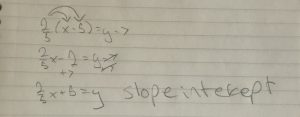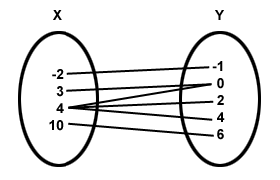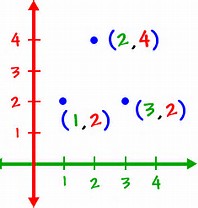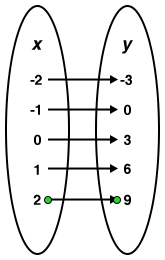week 18 in math 10
this week in math 10 we spent the week reviewing what we have learned throughout the semester in preparation for the final. I completed the review package A and B on my own time, and in class. my questions or misunderstandings were answered during class time when we went over common questions as a class. throughout this week I realized which units I needed to review more thoroughly and which units I fully understood. to help with review, with partners, we also used an online website “quizizz.com” and entered codes based off of the unit we wanted to study. I completed the quizzes for measurement and functions with my partner.
week 17 in math 10
this week in math 10 we started our unit on “systems of linear relations” I learned that a solution is the point on a graph at which two lines meet. depending on the relation of the two lines, there can be 1 system, infinite systems, or no systems at all. there is one system if the slopes to not match, there are an infinite amount if the slope and y-intercept of the lines match, and there are 0 solutions if the slopes are the same because this would represent parallel lines.
to find the solution of two lines we can use one of two methods, we can use the elimination method or the substitution method.
do demonstrate substitution for example we have the lines
8x-3y=10 , x-y=5
start off by choosing an equation of the two to isolate either y or x.
x-y=5 now turns into x=y+5
now we take the other equation 8x-3y=10, and replace x with y+5, becomes 8(y+5)-3y=10 , distribute the 8 into y and 5
8y+40-3y=10, combine like terms and isolate the variable to find the y coordinate.
8(y+5)-3y=10
8y+40-3y=10
5y=-30
5y/5=-30/5
y= -6
now to find the x-intercept we go back to one of the original equations and replace all of the y’s with -6
x-y=5
x-6=5
isolate the variable
x=-1 now we have the solution of these two lines as (-1,-6)
no verify this, we input the x and y into both original lines and if they are both equal then the question is complete
now to use elimination, a much quicker method.
we have the lines 2x+3y=7, 5x-3y=28
we can either add or subtract the two equations, the goal is to get two of the terms to cancel out to make the question simpler
2x+3y=7
5x-3y=28
add the equations together, in this case, +3y and -3y are opposites so they can cancel out and we are left with
7x=35 now isolate x
so x=5. now we input 5 into one of the original equations, replacing all of the x’s, to find the y-coordinate. then verify by inputting x and y into both original equations as we did for the substitution method.
week 15 in math 10
this week in math 10 I learned about parallel lines and perpendicular lines. I learned that the slope of parallel lines will always be the same, and that the slope of perpendicular lines will be negative reciprocals. a negative reciprocal for example: if one slope is then the slope of the line perpendicular will be
.
I also learned how to convert to point- slope form, to slope- intercept form, to general form, starting with a set of coordinates and a slope.
point- slope : m(x-x2)=y-y2
so if we have a slope of 2/5 and coordinates (5,7) , it would be written out as 2/5(x-5)=y-7
because m= 2/5, x2= 5 and y2= 7
then from there, to convert to slope- intercept form (y=mx+b) we need to isolate y, starting by distributing 2/5 into x and -5, then adding 7 to each side, finishing with +5=y

now to convert to general form (x+y+#=0) we need to get rid of all the fractions, and make sure the leading coefficient of x is positive.
because 2/5x is already positive we just need to move y over by subtracting it from each side, ending up with -y+5=0. then to get rid of the fractions we multiply everything with the common denominator which in this case is 5. general form: 2x-5y+25=0
week 14 in math 10
this week in math 10 I learned how to identify if a relation is a function. I learned that for a relation to be a function, it basically means that the input must have only have one output. on graph, a function would not have any dots sitting directly above each other:
where as in this graph does not represent a function because there are two points vertically above each other
you can also represent functions through mapping diagrams, a mapping diagram uses arrows to connect the inputs with the outputs, an example of a relation that is not a function would be this because 4, as you can see has arrows to three different outputs.
however this diagram represents a function because it is showing that every input number only has one output/one connecting arrow
week 13 in math 10
this week in math 10 I learned how to write an equation for y by looking at a set of numbers and using a T chart. for example this set of numbers:
-5,-2,1,4,7,10,13,16
we would draw out a T chart with the left side as X and the right side as Y. x being the input, y being the output. then under the X we would write 1,2,3,4….. and under the Y we would write our -5,-2,1,4,7,10… now we have to find a rule that will get the X number to the Y number, that will also work for all of the numbers. so 1 to -5, 2 to -2, 3 to 1, 4 to 4, 5 to 7 and so on. we can write the pattern of the numbers along with the starting point “start at -5 increase by 3 each time.” because its increasing by 3, we multiple 3 with X and then add/subtract a number to get Y. y=3(x)+or-#
replace x with a number 3(1)= 3 and we have to get to -5 so the equation would be 3(1)-8=-5. we can check if 3(x)-8 works for all the pairs of numbers by replacing X and if it does then the rule for this pattern would be 3(x)-8
week 11 in math 10
this week in math 10 i learned how to make a trinomial that has the “pattern” ( , x, #) look “nicer” if it was written out in a jumbled up order. ex 5x-
+40 is written as x,
, # rather than
, x, #. so we can write it as –
+5x+40 now, the
is negative so when we find the greatest common factor, we can take -5 instead of +5 to make it positive, which would also switch the other terms to their opposites, so –
+5x+40 is now -5(
-x-40)
week 10 in math 10
this week in math 10 I learned that if we have a binomial that says for example, this is considered a perfect square because
= (x)(x) , 81= (9)(9). there is no middle term because when factored it would look like (x-9)(x+9), then if you were to expand this back out, the -9 and the +9 would cancel out and become 0, leaving the answer to be a binomial instead of a trinomial. (x)(x)=
+ (x)(9)= +9x (-9)(x) = -9x (-9)(9) = -81
+ 9x – 9x -81 . the +9x and the -9x cancel out to be zero
for this to be a “perfect square” we need to make sure that each term is a perfect square and that the sign is subtraction, not addition
week 9 in math 10
this week we started our unit on polynomials, this was mainly review but i learned how to model binomials multiplied by binomials or binomials multiplied by trinomials or trinomials by trinomials etc, by using an area model. i also learned that you can use this type of model to model more than one digit number multiplication. for modeling polynomials, its all done in a box. if i had ( )(x-5) you would draw a square and divide it into 4 even squares, one for each piece of the expression and along the top you would write
then along the side you would write x-5 and you would fill in the box as if it were a multiplication chart so it would look like this….
then you add all of the squares together and combine like terms to get a simplified expression








